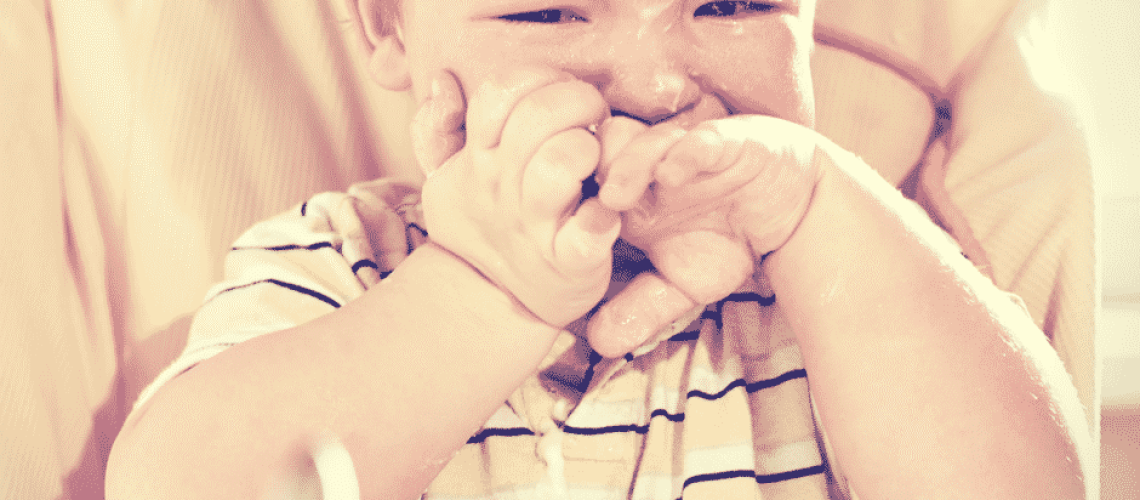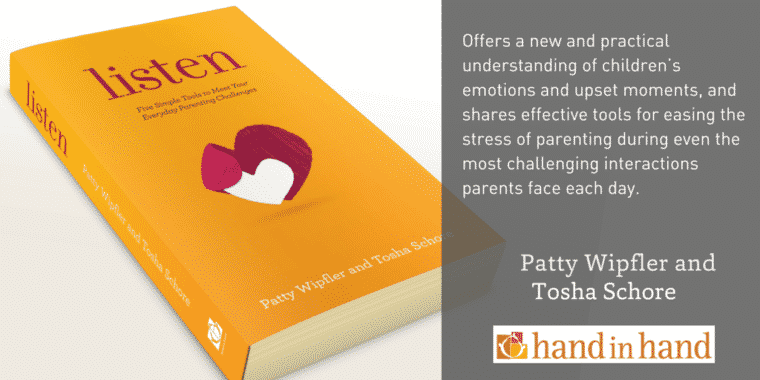Angie was unhappy. Her mommy and daddy had brought her and her baby sister to a playtime at the Junior Museum. There was just one other child there, Nora, who was, like Angie, three years old. They had been playing in opposite corners of the playroom for a good while without acknowledging one another’s presence. Angie had suddenly decided she wanted the blue ball that the Nora was playing with, and made a bee-line for it.

Seeing that the ball was about to be grabbed, I put my arm in front of Angie and said, “No, Nora has the blue ball. I’ll wait with you until Nora is done with it.” Angie screamed at the top of her lungs, and ran to her daddy.
“No” Leads to a Big Upset
Her daddy sat down on the floor and she scrambled into his lap, still screaming. She kicked the floor. She writhed in his arms. She shut her eyes tight and threw herself from side to side in his arms. She kept on screaming! I sat close, listening, and doing what I could to silently support her daddy, who was doing a good job of not trying to solve the blue ball problem.
We Could Only Guess the Real Reason Behind her Upset
Angie had launched an intense emotional episode, and her daddy said little, but anchored her well through this storm. I noted that her baby sister was quite young, perhaps just one or two months old. I wondered whether all this heat had something to do with having a new sibling and having to now share her parents’ attention. We’ll never know, because Angie’s passionate screams had no words.
She went on and on, sometimes throwing herself around in a kind of tantrum in her daddy’s lap. He and I kept on offering her Staylistening time. We said almost nothing beyond, “You’re safe. No one is upset with you.”
Why “No” is a Gift to Kids
“No” is a real gift at a time like this. The parent says “No” in plain language, with kindness attached. The parent keeps the child from doing things that will hurt the feelings of others, not with shame or blame, but, when necessary, with a physical barrier that prevents off-track behavior.
Showing “Yes” When You Say “No”
The parent communicates “Yes” in the nonverbal language of love. Yes, I offer you my love. Yes, I will listen to your whole, long, passionate upset. Yes, you may be as wildly irrational as you need to be while you clear the way for your mind to operate peacefully again. Yes, come and be in my arms, or if that makes you silent but still unhappy, then sit right next to me where you can have both me and your feelings. Yes, I guarantee you safe passage through this emotional storm. Yes, I know you will come out of this in a better frame of mind. Yes, you are my smart and healthy child.
Angie kept screaming and crying, but some children beg for something—anything—to make the feelings go away. For them, “No” needs to be said, with great warmth, again and again for them to clean out the tension that has engulfed them. Angie didn’t beg for distraction, but if she had, her daddy or I might have said,
- “I know you wanted the blue ball. Nora had it.You might get a turn later.”
- “Yes, I am here.”
- “No, you can’t have a cracker now. We can get one later.”
- “I’ll hold your hands so you don’t pull my hair. I will be gentle.”
- “No. No chips right now, either.”
- “Yes, I know you want them.”
- “No, we are not going home right now. We’ll go later, I promise.”
- “Yes, you are safe here. I am watching over you.”
- “No, I’m not going to get you a snack now.”
- “Yes, you have me. I’m right here. I won’t go away.”
- “No, we’ll get a snack later. No chips right now.”
A Parent Fills Deeply-Held Needs When They Listen
After about 20 minutes, her screams petered out, and she began to look around the room. Nora had been playing across the room with her father, and this long outburst didn’t seem to have dampened her spirits. I showed Angie that there was a green ball and a red ball available if she wanted. She was not interested. She sat peacefully with her daddy, studying the scene in the room.
How “No” Works to Clear Out Big Feelings and Fears
The clear verbal “No” opens the door to a child’s big invisible storehouse of feelings. The warm nonverbal “Yes, I’m here” starts the healing process.
The child is distraught. The parent indicates that all is actually safe.
The child feels need. The parent says, “I’ll give you me. I offer me and my caring.”
The child says, “That’s not good enough,” and cries until that feeling of upset has faded. Then, satisfaction is possible. The parent is plenty good enough.
After a quiet five minutes in her daddy’s lap, Angie got up and immediately went over to where Nora was playing. This was the first moment they had had any kind of interaction at all, but Angie could now connect, cooperate, and enjoy Nora and the rest of the playtime. They rode together on one of their daddy’s backs, jostling, laughing, and holding on to one another as though they’d known one another since birth. They built a cardboard block house together. They jumped and ran. There was not one hint of strife between them for the rest of the evening.
Use Staylistening to Wrap “No” in Your Warmest “Yes”
You’ll need to do a brave experiment with Staylistening to see this kind of remarkable transformation for yourself. You will see how useful “No” can be, and how listening to your child’s passionate upset can bring laughter and warm connection to the emotional tenor of the day. Your presence has power. Your listening can restore your child’s good judgment. You need not fear “No.” Simply add your warmest nonverbal “Yes,” and listen.
For more on supporting your child as he or she cries and tantrums read:
- The Science Behind the Hand in Hand Parenting Tool of Staylistening
- What to Say During Staylistening
- 17 Kind Ways To Say No To Your Child
Get monthly parenting tips to calm stress and ease your parenting challenges
Listen to a sample of our book Listen: Five Tools to Meet Your Everyday Parenting Challenges


